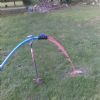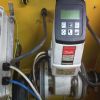Simple to complex testing undertaken
Pumping and control equipment
Monitoring and measuring equipment
Borehole and spring yield testing
A borehole pump test is a controlled experiment in which a borehole is pumped at a controlled rate and water-level response (draw-down) is measured.
A yield test on a spring can vary from a basic bucket test to more prolonged monitoring.
Depending on the application of the borehole a yield test may or may not be required. If the borehole is going to be used for a low demand or domestic system and the hydrogeologist, diviner or drilling company anticipate an adequate supply of water in the aquifer then a simple yield test using the final use pump is usually undertaken. This is generally installed in a temporary fashion to flush the borehole until it runs clear and establish that enough water is available.
If a borehole is to be used for a larger concern or requires proving for a particular application (e.g. an open source heat pump system) then a specific or measured yield test may be required. FWT can assist in specifying this test, however, if abstracting over 20m³ per day then an abstraction licence is required and the yield testing will need to be carried out in accordance with the requirements of The Environment Agency/ Natural Resources Wales.
Common yield (pump) tests are:
Constant rate tests: maintain pumping at the control well at a constant rate. This is the most common yield test and aims to provide an estimate of the hydraulic properties of an aquifer system such as its transmissivity, hydraulic conductivity and storage.
Step (draw down) tests: pumping for a sequence of constant-rate steps at thecontrol wellto determine its well loss and well efficiency characteristics. In a step (draw down) test, the discharge rate in the pumping well is increased from an initially low constant rate through a sequence of pumping intervals (steps) of progressively higher constant rates. Each step is typical of equal duration, lasting from approximately 30 minutes to 2 hours.
The pumping rates used in a step-draw down test should encompass the maximum design-pumping rate for the well (Qmax). The following table shows one possible scheme for the pumping rates in a step-draw down test consisting of four steps:
|
Step |
Rate |
|
1 |
0.5·Qmax |
|
2 |
0.75·Qmax |
|
3 |
Qmax |
|
4 |
1.25·Qmax |
FWT have a range of pumps and controls and can either carry out the tests for you or are happy to start the test and instruct a competent person to complete the monitoring. We also have a range of metering and measuring equipment to undertake the monitoring of the water levels that we can hire or loan.
| Related images in this section Click for a larger image and description |
|
|




